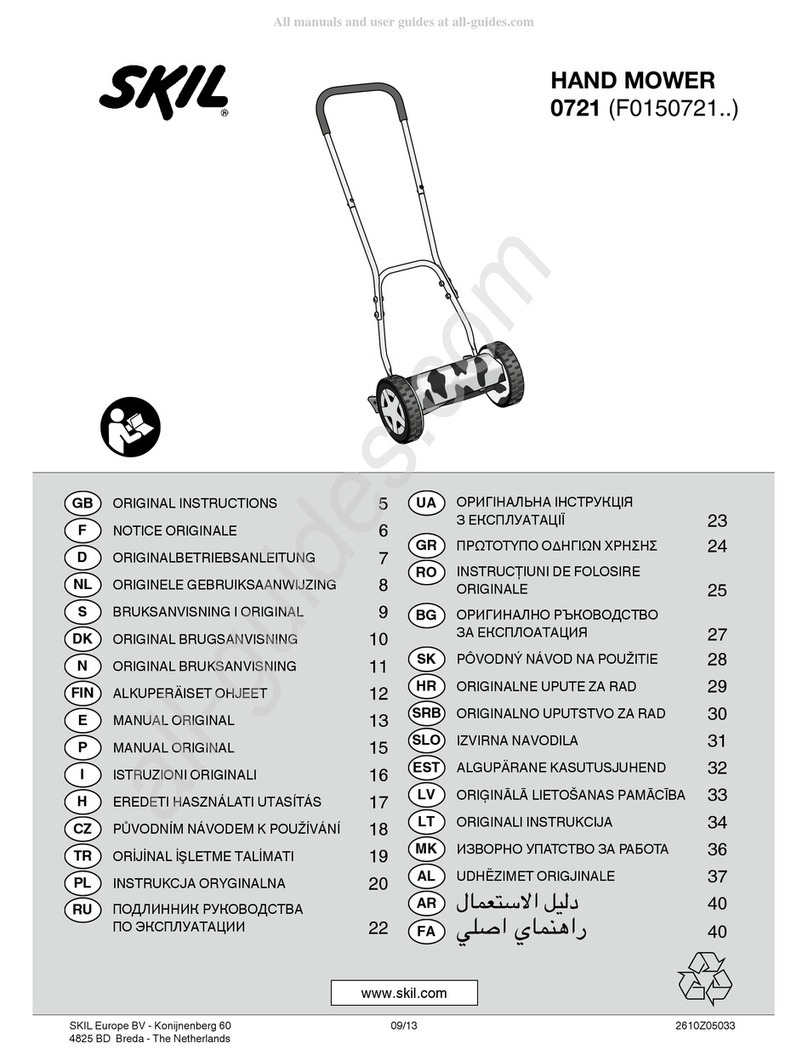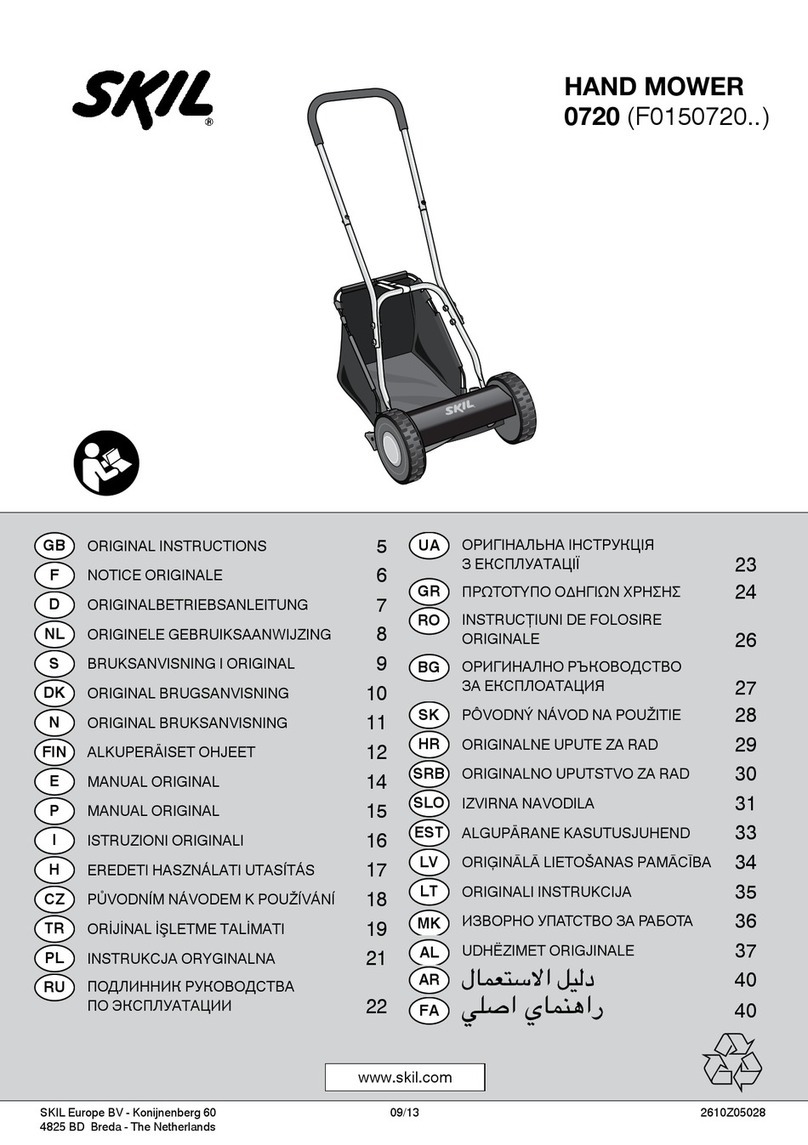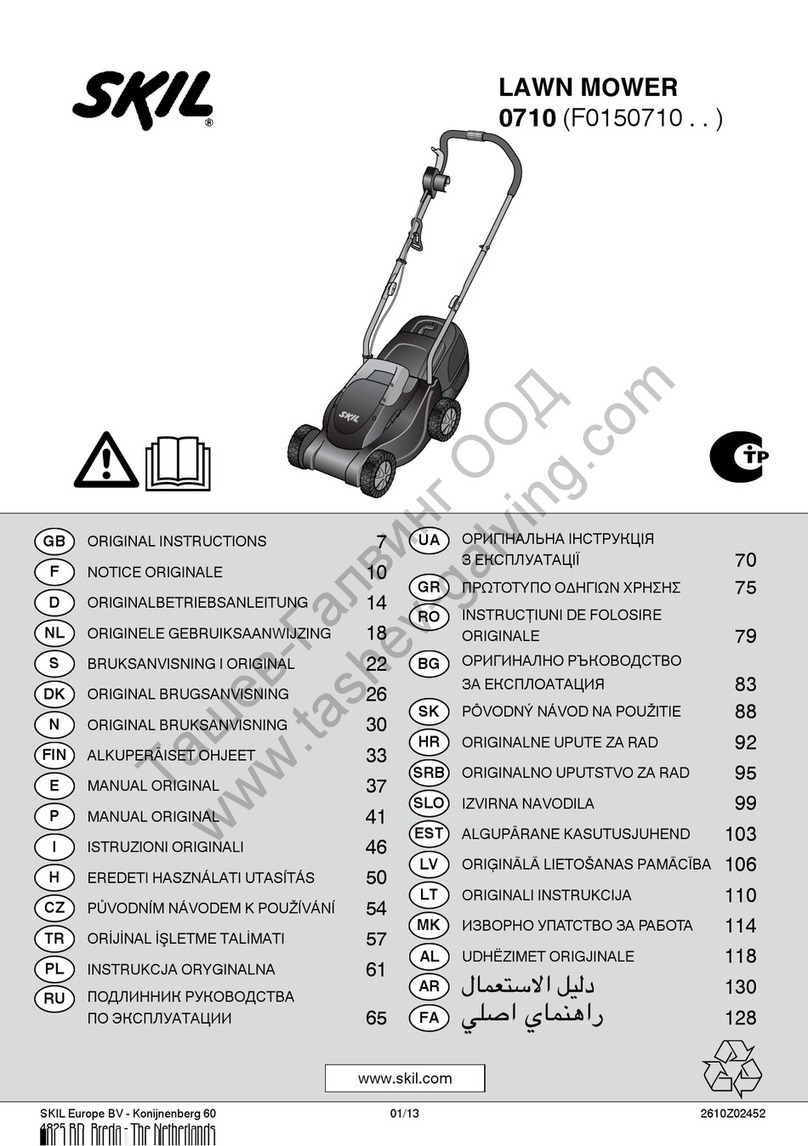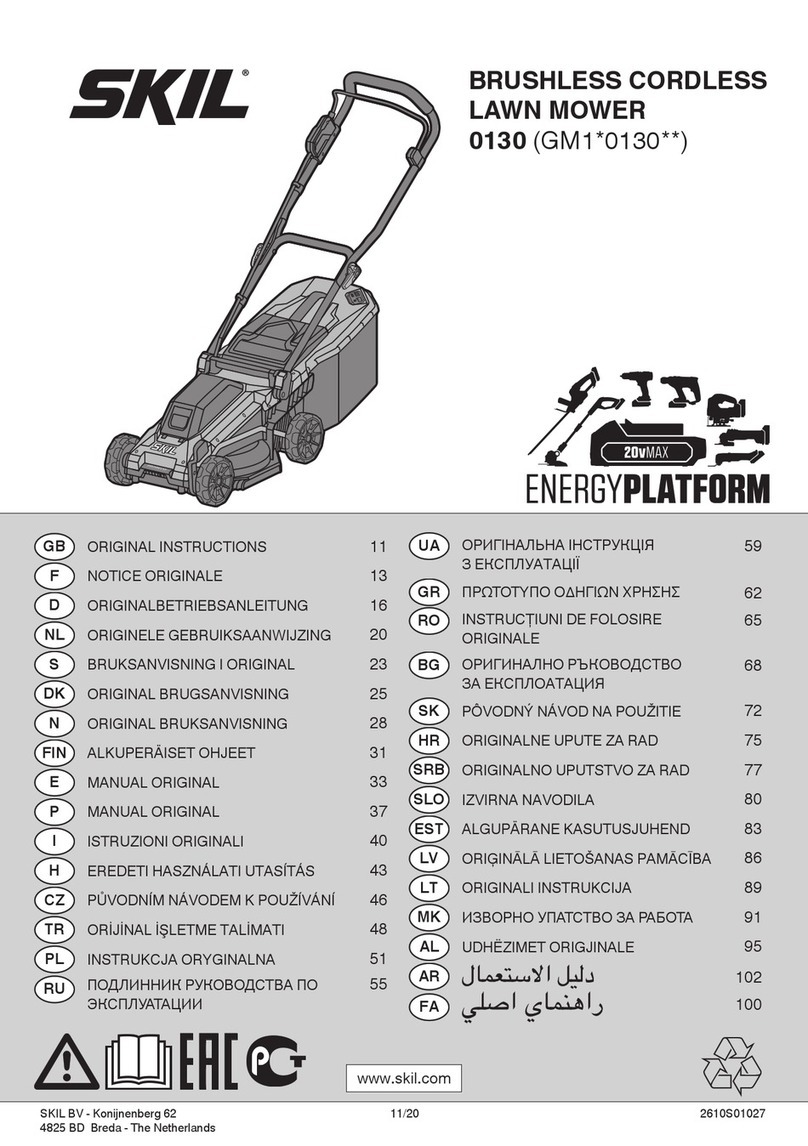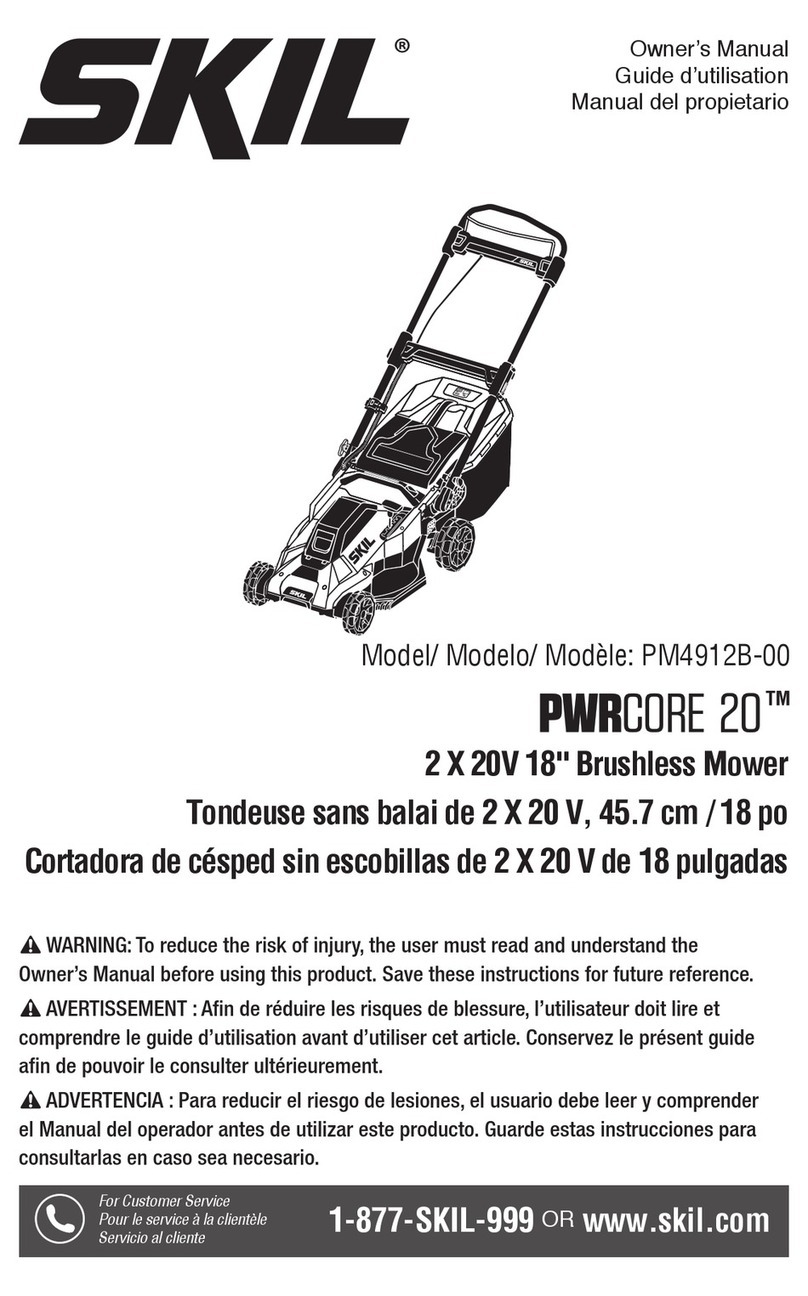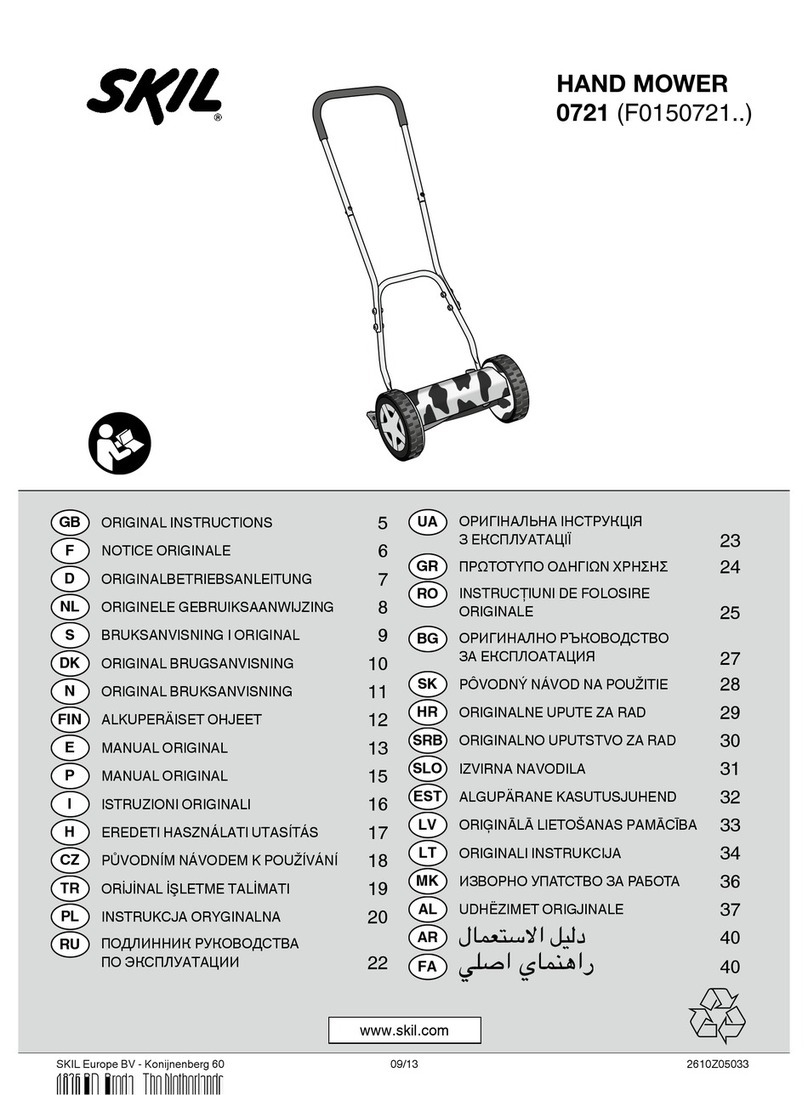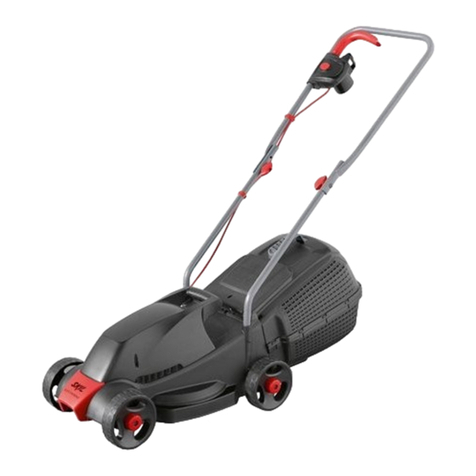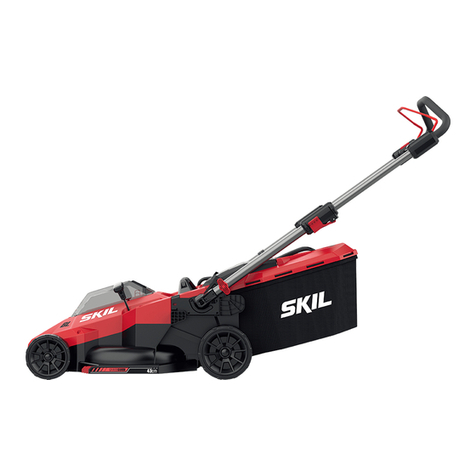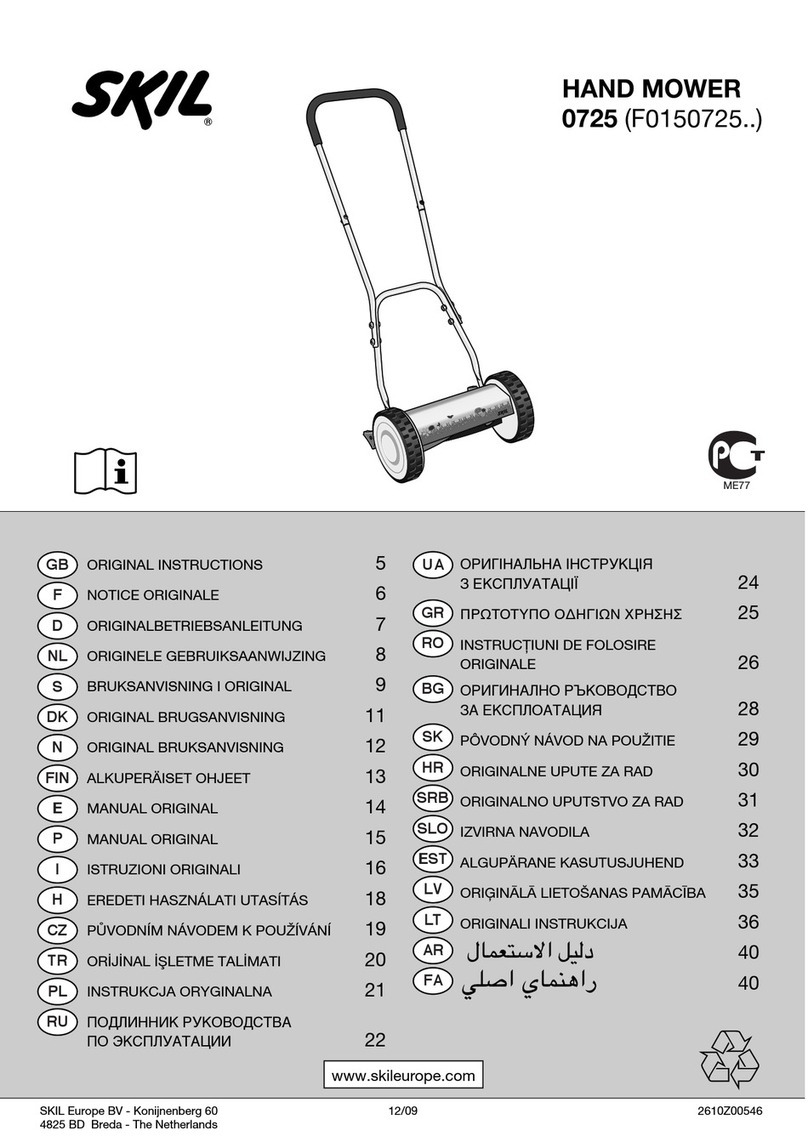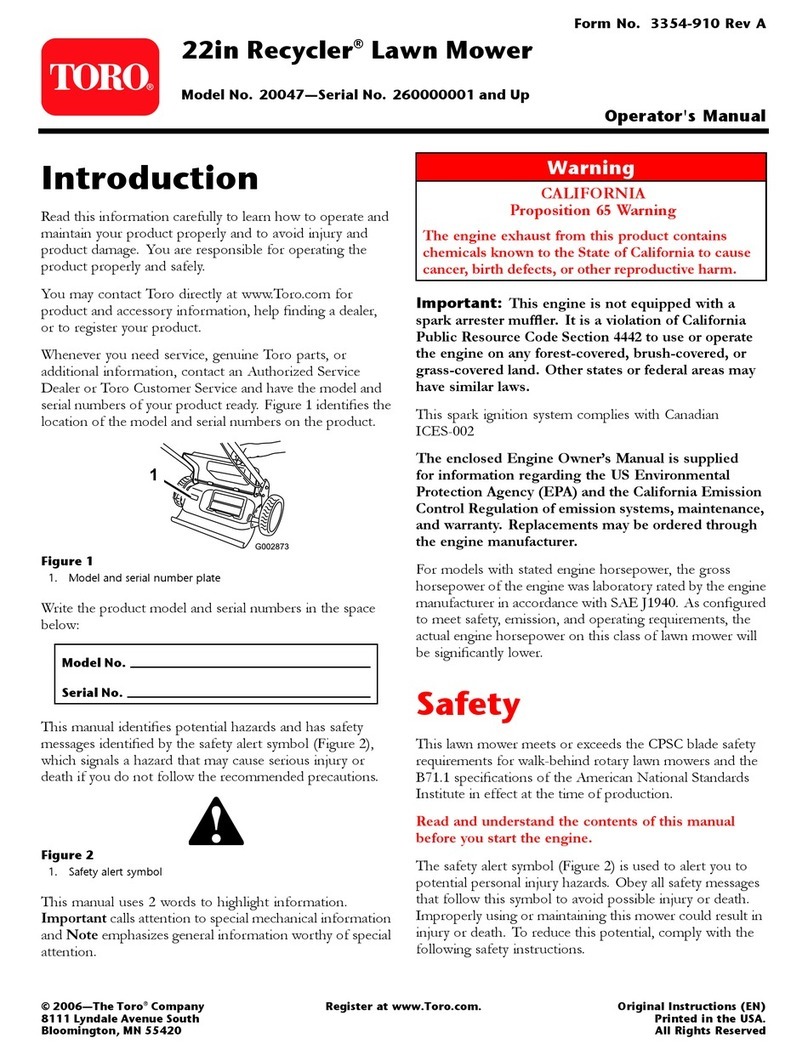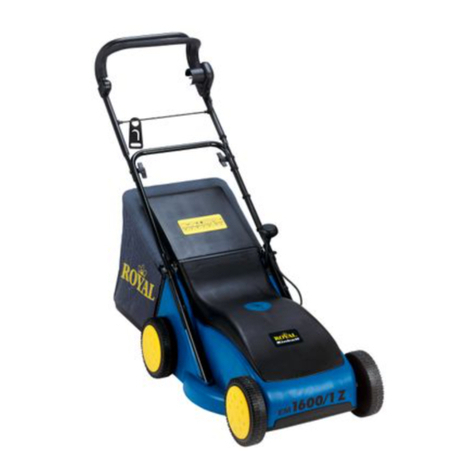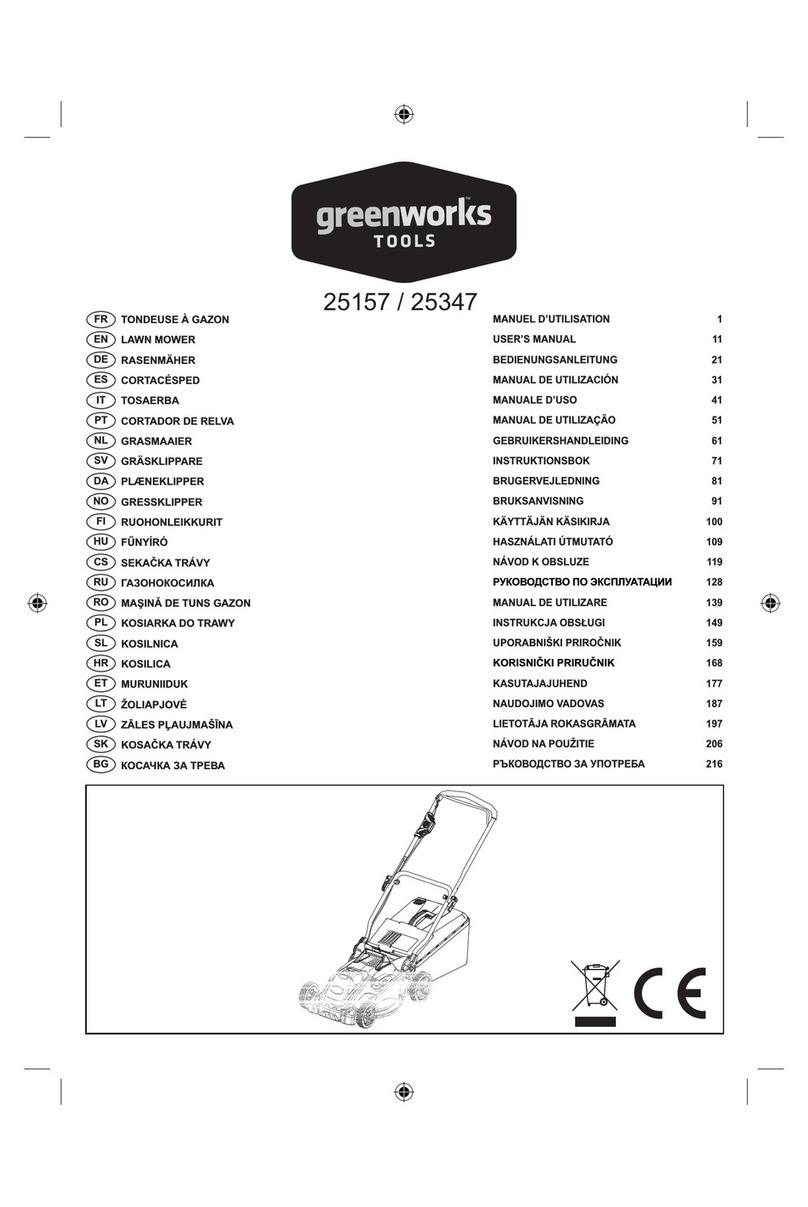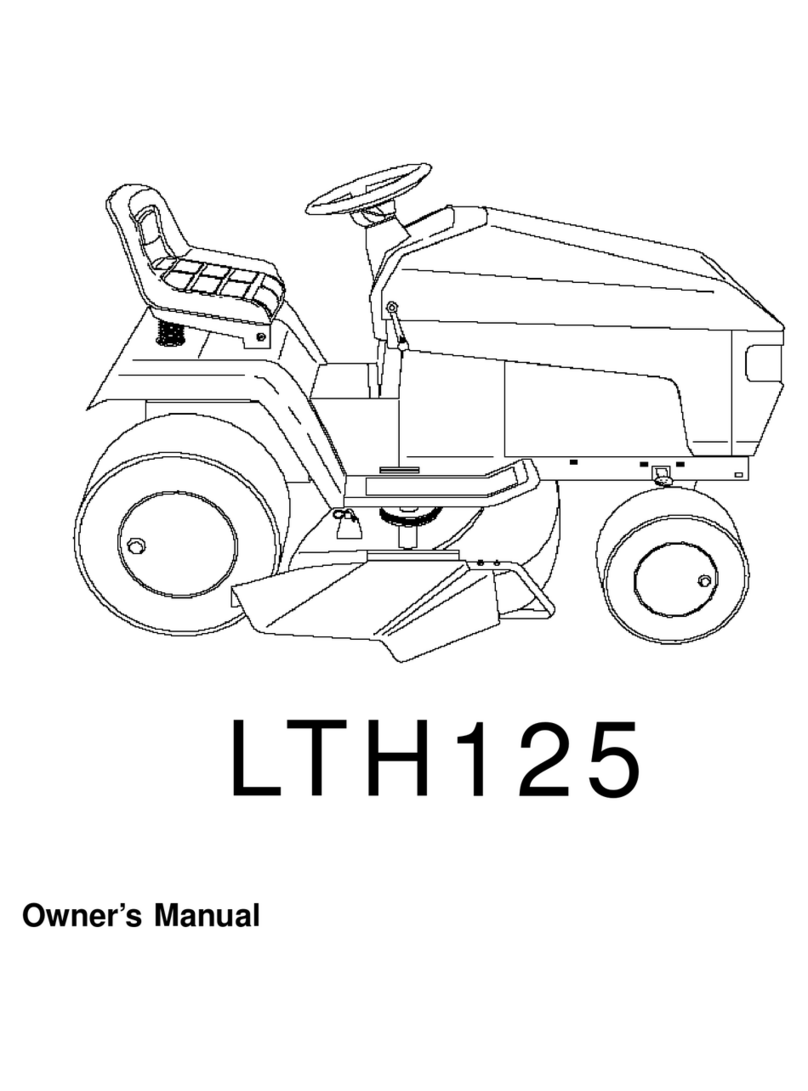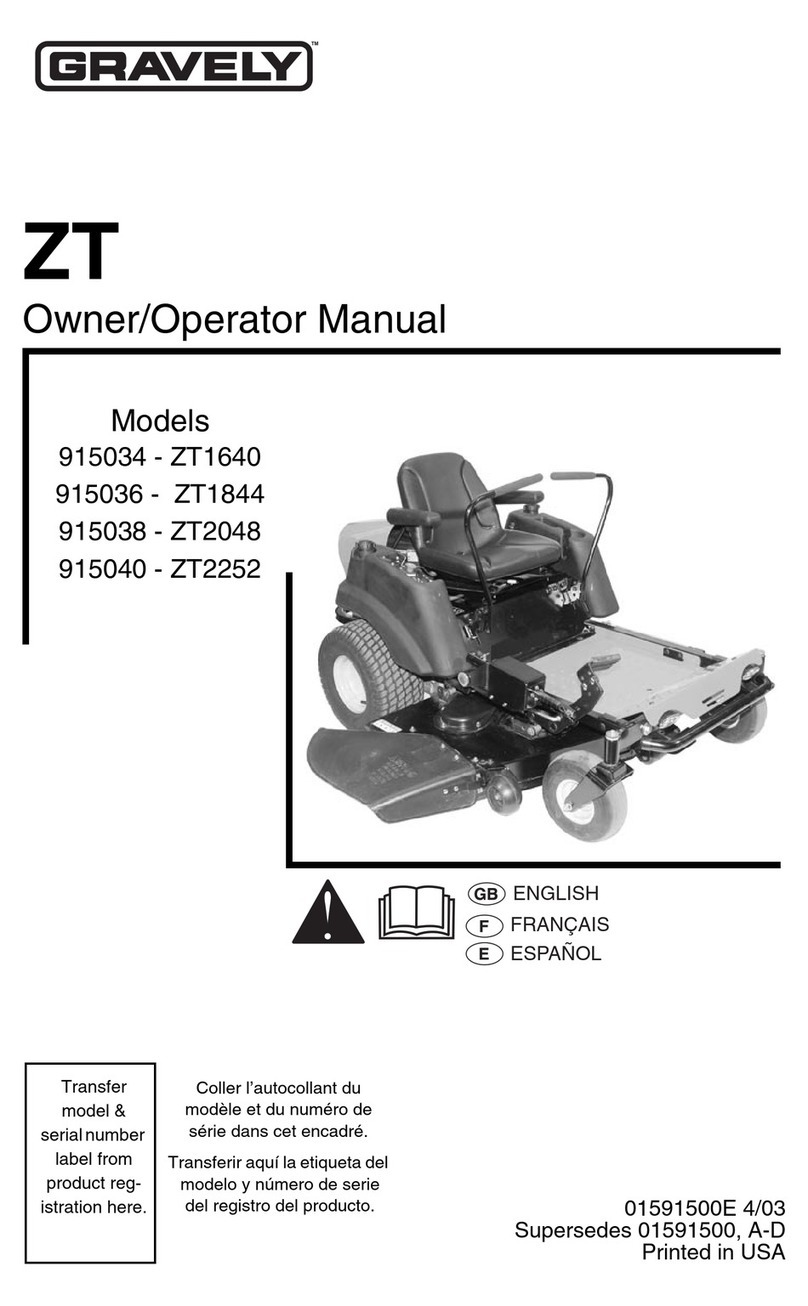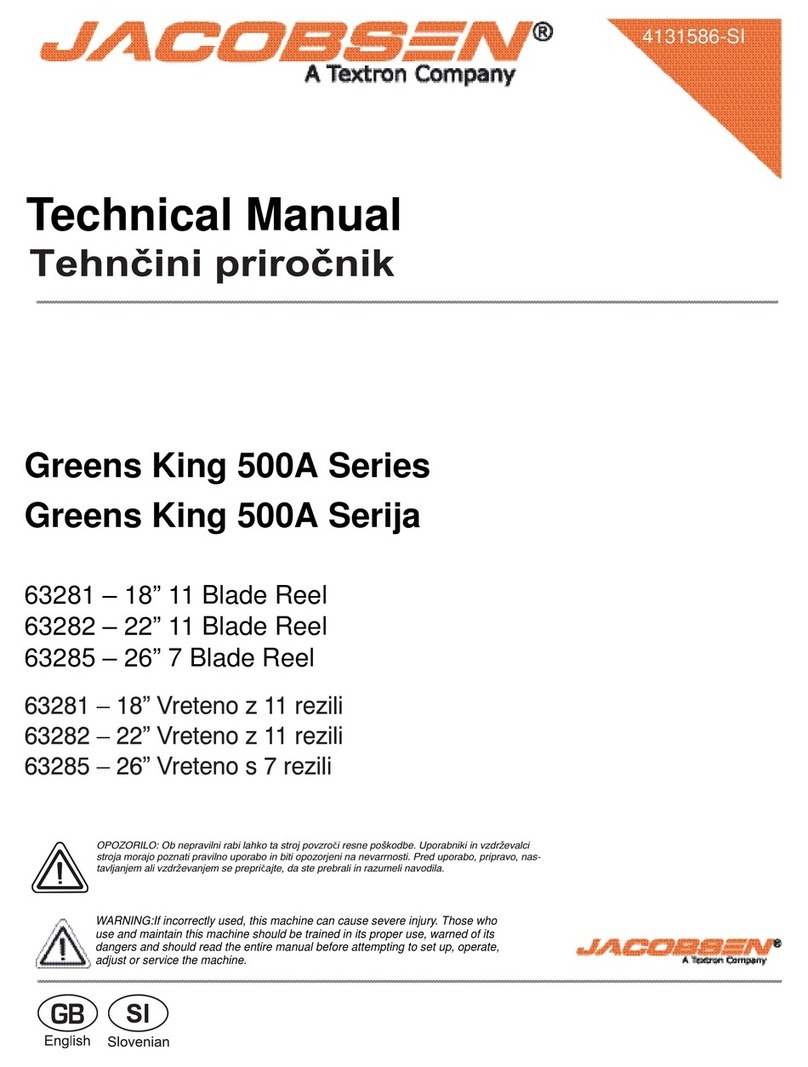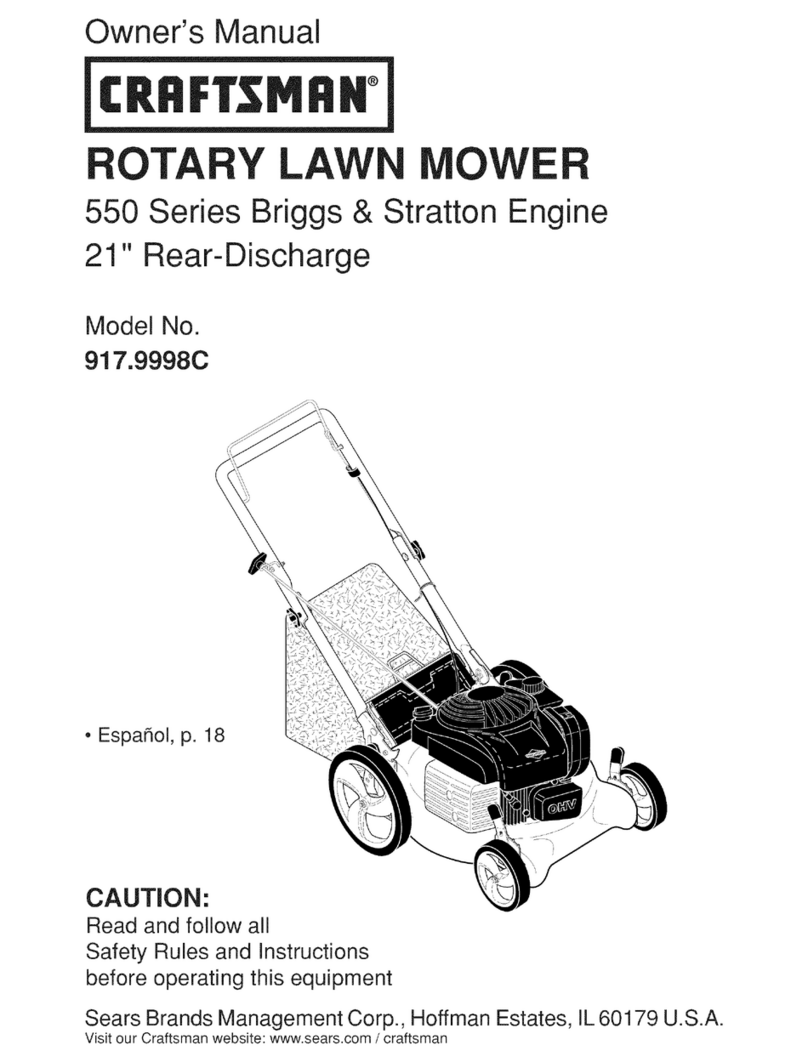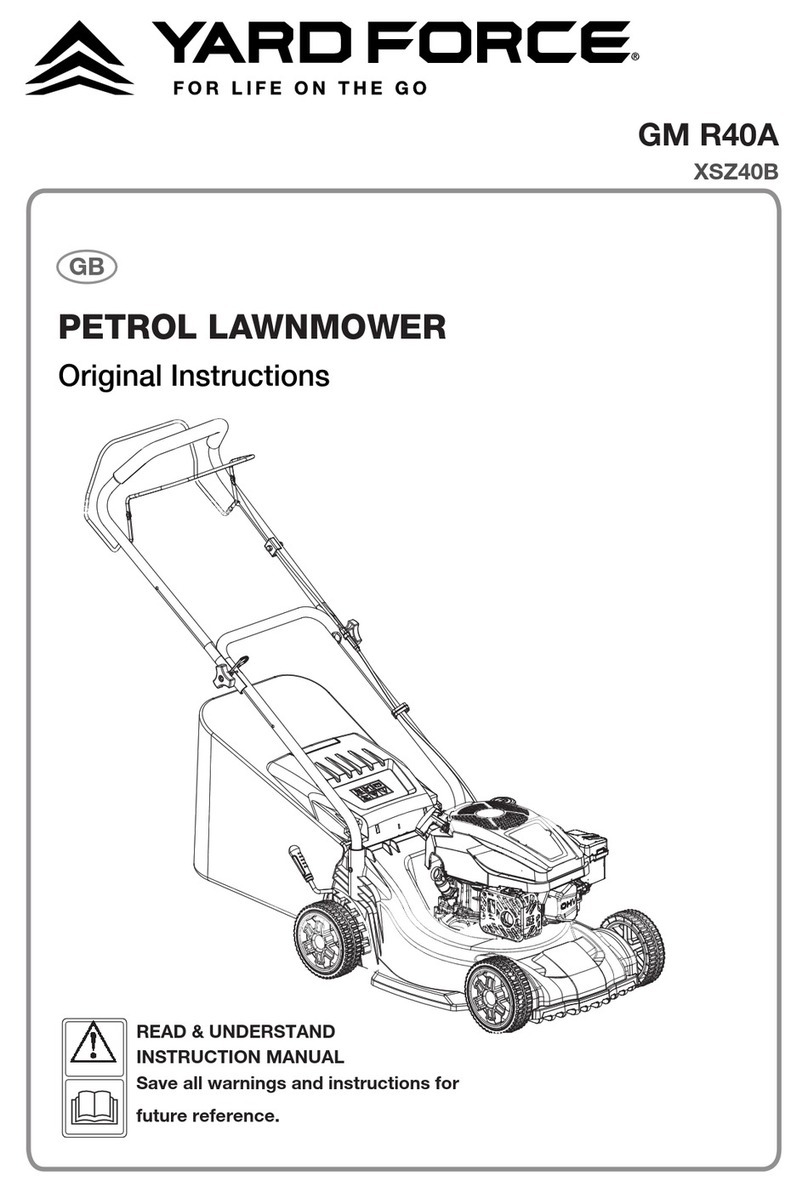Skil PM4910-00 User manual

WARNING: To reduce the risk of injury, the user must read and understand the
Owner’s Manual before using this product. Save these instructions for future reference.
AVERTISSEMENT : Afin de réduire les risques de blessure, l’utilisateur doit lire et
comprendre le guide d’utilisation avant d’utiliser cet article. Conservez le présent guide
afin de pouvoir le consulter ultérieurement.
ADVERTENCIA : Para reducir el riesgo de lesiones, el usuario debe leer y comprender
el Manual del operador antes de utilizar este producto. Guarde estas instrucciones para
consultarlas en caso sea necesario.
Owner’s Manual
Guide d’utilisation
Manual del propietario
For Customer Service
Pour le service à la clientèle
Servicio al cliente 1-877-SKIL-999 OR www.skil.com
40V 20" Brushless Lawn Mower
Tondeuse à gazon sans balais 40 V, 50,8 cm (20 po)
Cortadora de césped sin escobillas de 40 V de 20 pulgadas
Model/ Modelo/ Modèle: PM4910-00 / SM4910-00

2
TABLE OF CONTENTS
Safety Rules for Cordless Lawn Mower ...........................3-6
Symbols ....................................................7-10
Get to Know Your Lawn Mower ...................................11
Specications .................................................12
Accessory .................................................12-13
Assembly ..................................................14-17
Operating Instructions .......................................18-23
Maintenance................................................24-31
Troubleshooting ............................................32-33
Limited Warranty of SKIL Consumer Tool...........................34
WARNING
• Some dust created by power sanding, sawing, grinding, drilling and other construction
activities contains chemicals known to the State of California to cause cancer, birth defects
or other reproductive harm. Some examples of these chemicals are:
–Lead from lead-based paints.
–Crystalline silica from bricks, cement, and other masonry products.
–Arsenic and chromium from chemically-treated lumber.
• Your risk from these exposures varies, depending upon how often you do this type of work.
To reduce your exposure to these chemicals:
–Work in a well-ventilated area.
–Work with approved safety equipment, such as dust masks that are specially designed to
lter out microscopic particles.
–Avoid prolonged contact with dust from power sanding, sawing, grinding, drilling, and
other construction activities. Wear protective clothing and wash exposed areas with soap
and water. Allowing dust to get into your mouth or eyes or to lie on the skin may promote
absorption of harmful chemicals.

3
SAFETY RULES FOR CORDLESS LAWN MOWER
DANGER This machine was built to be operated according to the rules for safe
operation included in this manual. As with any type of power equipment,
carelessness or error on the part of the operator can result in serious injury. This machine is
capable of amputating hands and feet and throwing objects. Failure to observe all safety
instructions could result in serious injury or death.
WARNING When using electric lawn mowers, basic safety precautions should always
be followed to reduce the risk of re, electric shock, and personal injury.
These basic precautions include the following:
Children
Tragic accidents can occur if the operator is not alert to the presence of children.
Children are often attracted to the mower and mowing activity. They do not understand the
dangers. Never assume that children will remain where you last saw them.
• Keep children out of the mowing area and under the watchful care of a responsible adult
other than the operator.
• Be alert and turn the mower off if a child enters the area.
• Use extreme care when approaching blind corners, doorways, shrubs, trees, or other objects
that may obscure your vision of a child who may run into the mower.
• Never allow children under 14 years old to operate a power mower. Children 14 years old
and over should read and understand the operation instructions and safety rules in this
manual and should be trained and supervised by a parent. Only responsible individuals who
are familiar with these rules of safe operation should be allowed to use this machine.
Operation
General Operation:
• Read this operator’s manual carefully in its entirety before attempting to assemble this
machine. Read, understand, and follow all instructions on the machine and in the manuals
before operation. Be completely familiar with the controls and proper use of this machine
before operating it. Keep this manual in a safe place for future and regular reference.
• Use the right appliance – Do not use the lawn mower for any job except that for which it is
intended. Your lawn mower has been designed to perform only one job: to mow grass.
• Don’t overreach – Keep proper footing and balance at all times.
• Objects struck by the lawn mower blade can cause severe injuries to persons. The lawn
should always be carefully examined and cleared of all objects prior to each mowing.
• Keep the area of operation clear of all persons, particularly small children, and pets.
• Before and while moving backwards with the mower, look behind and down for small
children and other people.
• Keep clear of the discharge opening at all times.
• This machine is a precise piece of power equipment, not a plaything. Therefore, exercise
extreme caution at all times. Your unit has been designed to perform one job: to mow grass.
Do not use it for any other purpose.
• Don’t force the lawn mower – it will do the job better and more safely at the rate for which it
was designed.
• Thoroughly inspect the area where the equipment is to be used. Remove all stones, sticks,
wire, toys and other foreign objects that could be tripped over or picked up and thrown by
the blade. Thrown objects can cause serious personal injury.
• Plan your mowing pattern to avoid discharge of material toward roads, sidewalks, bystanders
and the like. Also, avoid discharging material against walls or obstructions, which may cause

4
discharged material to ricochet back toward the operator.
• To help avoid blade contact or an injury from thrown objects, stay in the operator zone
behind the handles and keep children, bystanders, helpers and pets at least 100 feet (30m)
from the mower while it is in operation. Stop the machine if anyone enters the area.
• Always wear safety glasses or safety goggles during operation and while performing an
adjustment or repair to protect your eyes. Thrown objects that ricochet can cause serious
injury to the eyes. Always use a face or dust mask if the operation is dusty.
• Dress properly – Do not wear loose clothing or jewelry. They can be caught in moving parts.
Use of rubber gloves and footwear is recommended when working outdoors. Wear sturdy,
rough-soled work shoes and close-tting slacks and shirts. Shirts and pants that cover the
arms and legs and steel-toed shoes are recommended. Never operate this machine in bare
feet, sandals, slippery or lightweight (e.g., canvas) shoes.
• Do not put hands or feet near rotating parts or under the cutting deck. Contact with the blade
can amputate hands and feet.
• A missing or damaged discharge cover can cause blade contact or injuries from thrown
objects.
• Many injuries occur as a result of the mower being pulled over the foot during a fall caused
by slipping or tripping. Do not hold onto the mower if you are falling; immediately release the
handle.
• Never pull the mower back toward you while you are walking. If you must back the mower
away from a wall or obstruction, rst look down and behind you to avoid tripping, and then
follow these steps:
– Step back from mower to fully extend your arms.
– Be sure you are well balanced with sure footing.
– Pull the mower back slowly, no more than half way toward you.
– Repeat these steps as needed.
• Do not operate the mower while under the inuence of alcohol or drugs.
• Stay alert – watch what you are doing. Use common sense. Do not operate the lawn mower
when you are tired.
• The motor/blade control handle is a safety device. Never attempt to bypass its operation.
Doing so makes the safety device inoperative and may result in personal injury through
contact with the rotating blade. The motor/blade control handle must operate easily in both
directions and automatically return to the disengaged position when released.
• Avoid dangerous environments – Don’t use lawn mowers in damp or wet locations so as to
avoid slipping and falling during operation.
• Always be sure of your footing. A slip and fall can cause serious personal injury. If you feel
you are losing your footing, release the motor/blade control handle immediately and the
blade will stop rotating within three seconds.
• Mow only in daylight or good articial light. Walk, never run while operating.
• Stop the blade when crossing gravel drives, walks or roads.
• If the equipment should start to vibrate abnormally, immediately stop the motor, remove the
battery and check for the cause. Vibration is generally a warning of trouble.
• Never operate the mower without the proper trailing shield, discharge cover, grass bag,
mulching insert, side discharge chute, motor/blade control handle or other safety protective
devices in place and working. Never operate the mower with damaged safety devices.
Failure to do so can result in personal injury.
• Always stop the motor before making adjustments to a wheel or a cutting-height adjustment.
• If situations occur that are not covered in this manual, use care and good judgment. Contact
SKIL Customer Service for assistance.

5
• Use only the charger supplied by the manufacturer to recharge.
• Do not charge the battery pack outdoors.
• Do not charge the battery pack in rain or in wet locations.
• Use the lawn mower only with specically designated battery pack. Use of any other
batteries may create a risk of re.
• Use only with battery packs and chargers listed below.
Battery Charger
BY8705-00
BY8708-00
SC5364-00
SC5376C-00
Operation On A Slope:
Slopes are a major factor related to slip-and-fall accidents, which can result in severe injury.
Operation on slopes requires extra caution. If you feel uneasy on a slope, do not mow it. For
your safety, use the slope gauge in this manual to measure slopes before operating this unit
on a sloped or hilly area. If the slope is greater than 15 degrees, do not mow it.
Do:
• Mow across the face of slopes; never mow up and down. Exercise extreme caution when
changing direction on slopes.
• Watch for holes, ruts, rocks, hidden objects, or bumps which can cause you to slip or trip.
Tall grass can hide obstacles.
Do not:
• Do not mow near drop-offs, ditches or embankments; you could lose your footing or balance.
• Do not mow slopes greater than 15 degrees, as shown on the slope gauge.
• Do not mow on wet grass. Unstable footing could cause slipping.
Service
WARNING Grass bag components, the discharge cover, side discharge chute,
mulching insert and trailing shield are subject to wear and damage, which
could expose moving parts or allow objects to be thrown and could increase the risk of injury.
For safety protection, frequently check all components and replace damaged components
immediately with identical replacement parts. Contact SKIL Customer Service for assistance.
• Remove or disconnect the battery pack before servicing, cleaning, or removing material from
the lawn mower.
• Do not wash the mower with a hose; avoid getting water in the motor and electrical
connections.
• Before cleaning the machine, turn the motor off and wait until the blade comes to a complete
stop, then remove the battery pack. The cutting blade continues to rotate for a few seconds
after the motor is shut off. Never place any part of the body in the blade area until you are
sure the blade has stopped rotating. Then unclog the chute or remove or replace the grass
bag, or mulching insert.
• Follow instructions for lubricating and changing accessories.
• Keep handles dry, clean and free from oil and grease.
• To reduce a re hazard, keep the motor cover free of grass, leaves and debris build-up.
• Check the blade and motor mounting bolts at frequent intervals for proper tightness. Also,
visually inspect the blade for damage (e.g., bending, cracking and wear.). Replace the blade
only with the identical replacement blade.

6
• Maintain your mower with care – keep the mower blade sharp and clean for the best and
safest performance. Mower blades are sharp and can cut. Wrap the blade or wear gloves
and use extra caution when servicing it.
• Keep all nuts, bolts, and screws tight to be sure the equipment is in safe working condition.
• Never remove or tamper with safety devices. Regularly check their proper operation.
Never do anything to interfere with the intended function of a safety device or to reduce the
protection provided by a safety device.
• After striking a foreign object, stop the motor, remove the battery pack, allow the blade to
stop rotating, and thoroughly inspect the mower for any damage. Repair the damage before
operating the mower.
• Remove the battery and store the idle lawn mower in a covered area when not in use. Allow
the motor to cool before storing it in any enclosure. The lawn mower should be stored in a
dry, high, or locked-up enclosure, out of reach of children.
• Maintain or replace safety and instruction labels, as necessary.
• Do not incinerate the appliance even if it is severely damaged. The batteries can explode in
a re.
• Do not expose a battery pack or tool to re or excessive temperature. Exposure to re or
temperature above 212 °F (100°C) may cause explosion.
• When servicing, use only identical replacement parts. Use of parts that do not meet the
original equipment specications may lead to improper performance and compromised
safety.
• SAVE THESE INSTRUCTIONS. Refer to them frequently and use them to instruct others
who may use this tool. If you lend this tool to someone else, also lend these instructions to
them to prevent misuse of the product and possibly injury.
SAVE THESE INSTRUCTIONS!

7
SYMBOLS
Safety Symbols
The purpose of safety symbols is to attract your attention to possible dangers. The safety
symbols and the explanations with them deserve your careful attention and understanding.
The symbol warnings do not, by themselves, eliminate any danger. The instructions and
warnings they give are no substitutes for proper accident prevention measures.
WARNING Be sure to read and understand all safety instructions in this Owner’s
Manual, including all safety alert symbols such as “DANGER,”
“WARNING,” and “CAUTION” before using this tool. Failure to following all instructions listed
below may result in electric shock, re, and/or serious personal injury.
The denitions below describe the level of severity for each signal word. Please read the manual
and pay attention to these symbols.
This is the safety alert symbol. It is used to alert you to potential
personal injury hazards. Obey all safety messages that follow this
symbol to avoid possible injury or death.
DANGER DANGER indicates a hazardous situation which, if not avoided, will
result in death or serious injury.
WARNING WARNING indicates a hazardous situation which, if not avoided, could
result in death or serious injury.
CAUTION CAUTION, used with the safety alert symbol, indicates a hazardous
situation which, if not avoided, will result in minor or moderate injury.
Damage Prevention and Information Messages
These inform the user of important information and/or instructions that could lead to equipment
or other property damage if they are not followed. Each message is preceded by the word
“NOTICE”, as in the example below:
NOTICE: Equipment and/or property damage may result if these instructions are not followed.
WARNING The operation of any power tools can result in foreign
objects being thrown into your eyes, which can result
in severe eye damage. Before beginning power tool operation, always
wear safety goggles or safety glasses with side shields and a full face
shield when needed. We recommend a Wide Vision Safety Mask for use
over eyeglasses or standard safety glasses with side shields. Always
use eye protection which is marked to comply with ANSI Z87.1.

8
SYMBOLS (CONTINUED)
IMPORTANT: Some of the following symbols may be used on your tool. Please study them
and learn their meaning. Proper interpretation of these symbols will allow you to operate the
tool better and more safely.
Symbol Name Designation/Explanation
V Volts Voltage (potential)
AAmperes Current
Hz Hertz Frequency (cycles per second)
WWatt Power
kg Kilograms Weight
min Minutes Time
s Seconds Time
Wh Watt-hours Battery capacity
Ah Ampere-Hours Battery capacity
ØDiameter Size of drill bits, grinding
wheels, etc.
n0No load speed Rotational speed, at no load
nRated speed Maximum attainable speed
…/min Revolutions or reciprocation per
minute
Revolutions, strokes, surface
speed, orbits, etc. per minute
IPX4 Ingress Protection Degree Protection from splashing water
Arrow Action in the direction of arrow
Alternating current Type or a characteristic of
current
Direct current Type or a characteristic of
current
Maintain Safety Devices Do not open or remove safety
shields while the tool is running.
Look Behind While Backing
Look down and behind rst
to avoid tripping when pulling
back.
DANGER - Keep Bystanders
Away
Do not mow when children or
others are nearby.

9
Symbol Name Designation/Explanation
KEEP HANDS and FEET AWAY
GARDEZ VOS MAINS et VOS PIEDS À DISTANCE
MANTENGA LAS MANOS Y LOS PIES ALEJADOS
DANGER - Keep Hands and
Feet Away
To reduce the risk of injury,
keep hands and feet away from
rotating parts. Do not operate
unless discharge cover or grass
bag is in its proper place. If
damaged, replace immediately.
DANGER – Thrown Debris
Remove objects that can be
thrown by the blade in any
direction. Wear safety glasses.
DANGER - Steep Slope Hazard
Use extra caution on slopes. Do
not mow slopes greater than 15
degrees.
Li-ion RBRC seal Designates Li-ion battery
recycling program
Read manual symbol Alerts user to read manual
Wear eye protection symbol
Always wear safety goggles or
safety glasses with side shields
and a full face shield when
operating this product.

10
SYMBOLS (CERTIFICATION INFORMATION)
IMPORTANT: Some of the following symbols for certication information may be used on your
tool. Please study them and learn their meaning. Proper interpretation of these symbols will
allow you to operate the tool better and more safely.
Symbol Designation/Explanation
This symbol designates that this tool is listed by Underwriters Laboratories.
This symbol designates that this component is recognized by
Underwriters Laboratories.
This symbol designates that this tool is listed by Underwriters
Laboratories, to United States and Canadian Standards.
This symbol designates that this tool is listed by the Canadian
Standards Association.
This symbol designates that this tool is listed by the Canadian
Standards Association, to United States and Canadian Standards.
This symbol designates that this tool is listed by the Intertek Testing
Services, to United States and Canadian Standards.
This symbol designates that this tool complies to NOM Mexican
Standards.
This manual suits for next models
1
Table of contents
Languages:
Other Skil Lawn Mower manuals
